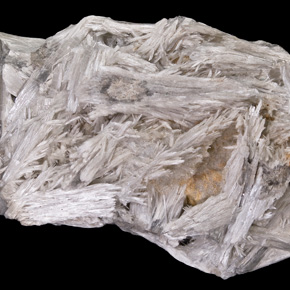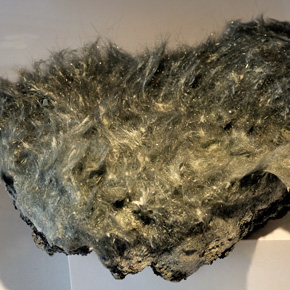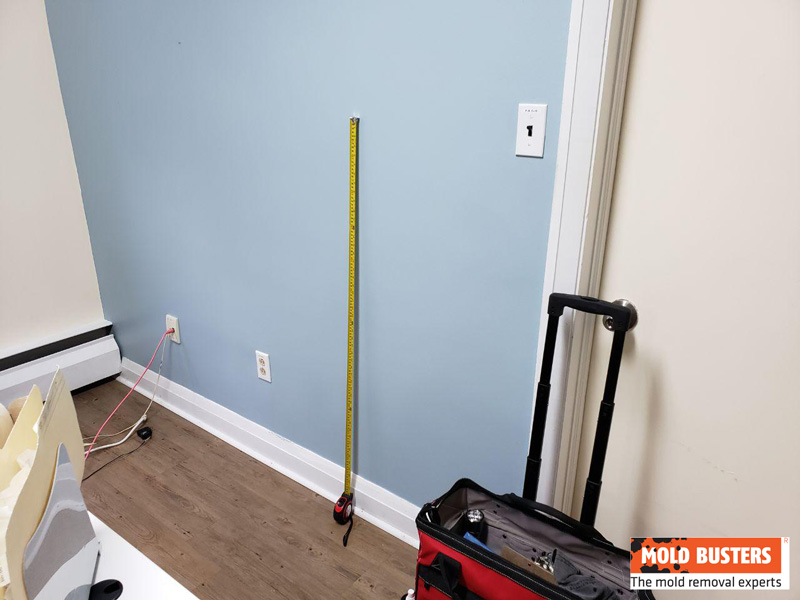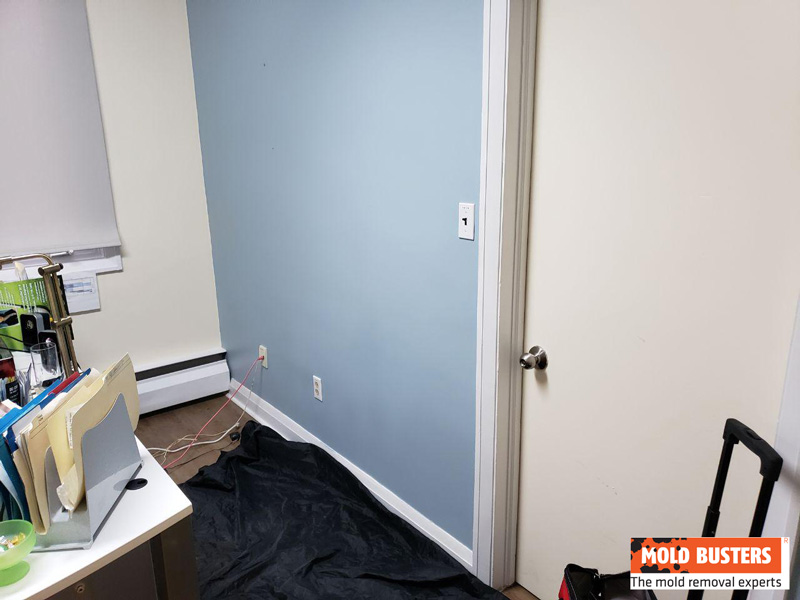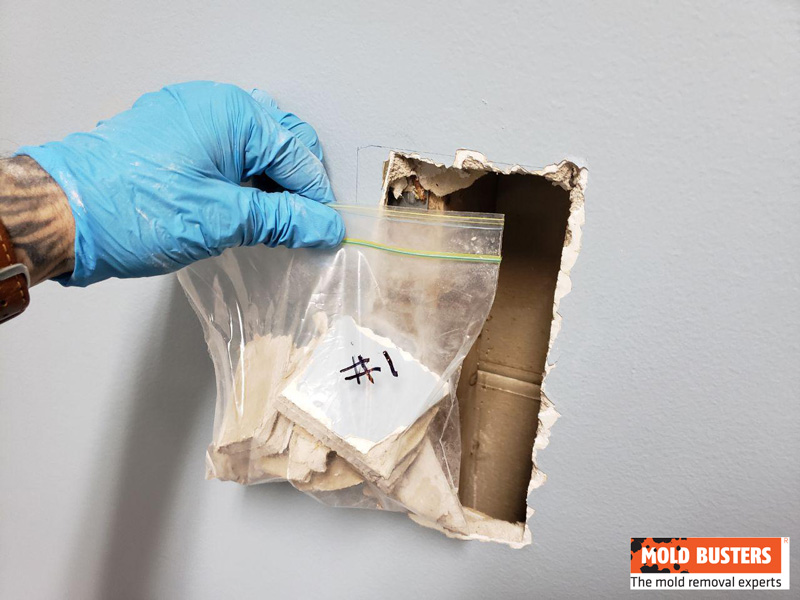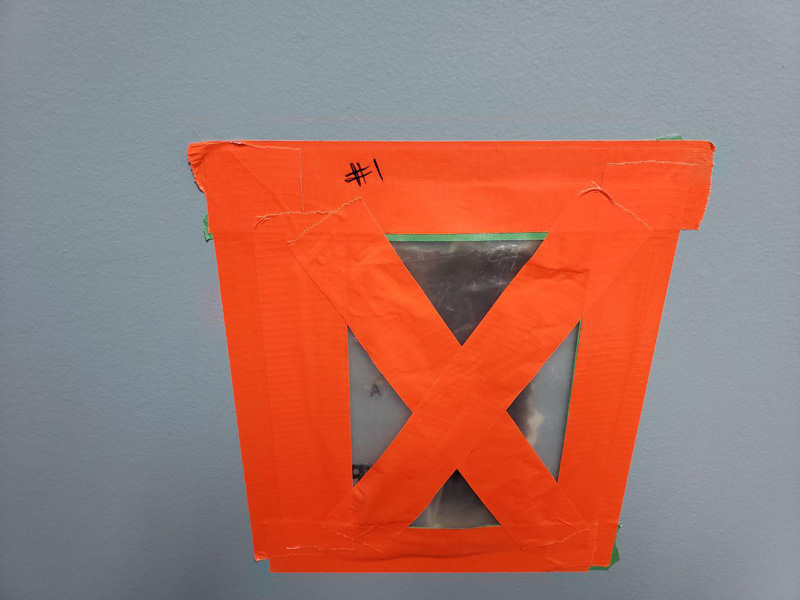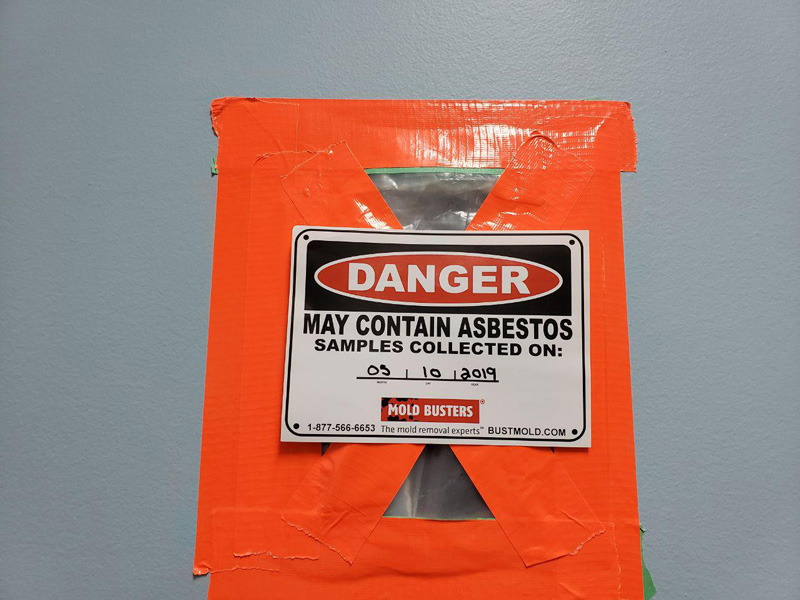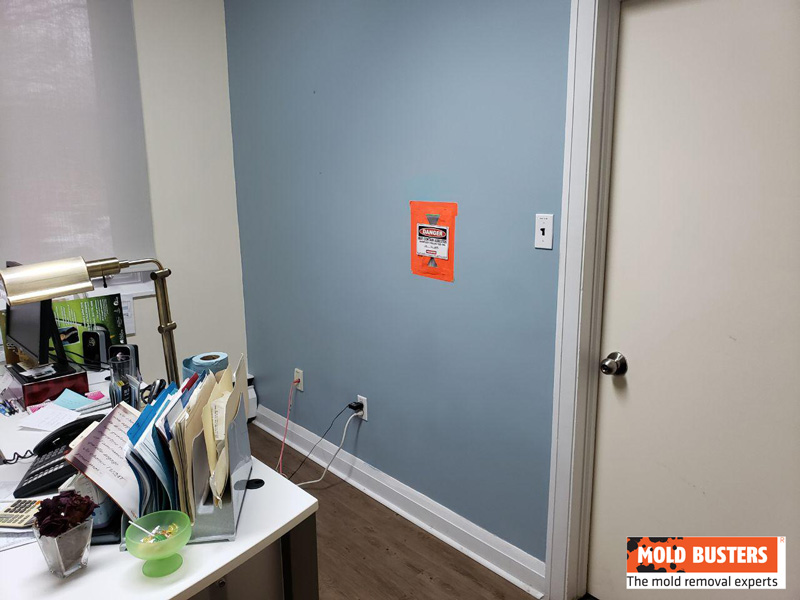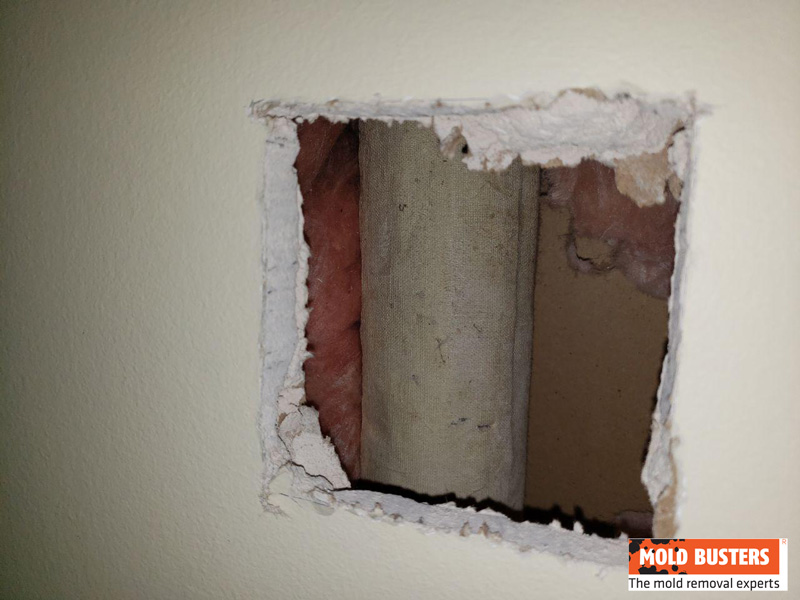Asbestos in Drywall
Asbestos was commonly used in drywall construction for many years, and the outright banning of the material in Canada only started in 2018! That means there’s a chance your property contains it as well. Informed by our extensive experience in asbestos testing, let’s dive deeper into how its inclusion in drywall can be a nightmare for your health, plus how to get rid of it safely.
In this article, we will give you a brief rundown of what asbestos is and how it can be safely tested and removed from the drywall in your home.
What is asbestos in drywall?
Asbestos is a fibrous material made up of six different naturally occurring mineral substances. These substances are known for being fire resistant and for protecting against chemical corrosion.
Asbestos fibres are flexible, soft, and can be mixed into other materials—such as plastic or cement—in order to make them stronger.
When was asbestos used in drywall?
- Small amounts of asbestos can sometimes be found in the “mud” or sealing agent used to fill gaps between drywall boards.
- Asbestos was also used for fireproofing and insulation against cold and noise in many buildings and homes built before the 1990s.
- Other commercial and construction industry products known to contain asbestos include floor and ceiling tiles, popcorn ceilings, house siding, industrial furnace and heating systems, car and truck brake pads, and vehicle transmission components.
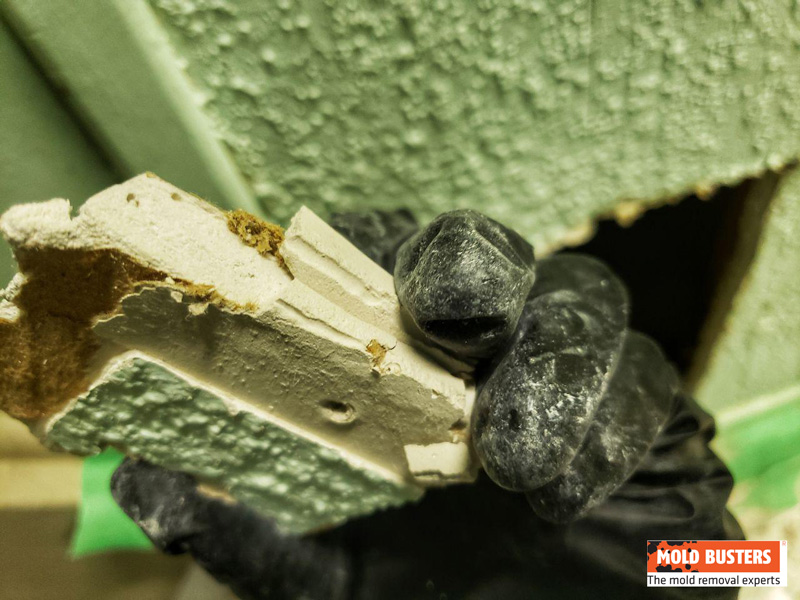
How common is asbestos in drywall?
Prior to the implementation of current health and safety regulations, asbestos was often thought of as a “magical material” and was a popular construction materials for decades.
Today over 50 countries (1) have regulations that prohibit the use of asbestos in their products, but several nations — including China, Russia, the United States, and Canada (1) — still allow trace amounts (2 percent or less) of the substance to be used in certain items.
However, if your home was built between 1950 and 1990, there is a big chance that it contains higher than acceptable levels of asbestos. This puts you and your loved ones at an increased risk of exposure if the fibres happen to be disturbed.
What type of asbestos is used in drywall?
There are six legally recognized types of asbestos, the most common being chrysotile (aka “white asbestos”). Made popular as a key ingredient in drywall, white asbestos accounts for 95 percent of worldwide asbestos use..
The other five known types of asbestos are crocidolite, amosite, anthophyllite, tremolite, and actinolite. Despite public knowledge of the long-term health hazards associated with asbestos exposure, the Canadian government has withheld from placing an outright ban on the substance, banned use of asbestos as of 30th of December, 2018.
What does asbestos in drywall look like?
Asbestos fibres are microscopic in size but can be pulled into a material that is fluffy in consistency because of their softness and flexibility. This makes them easy to work with for manufacturers in commercial and construction industries.
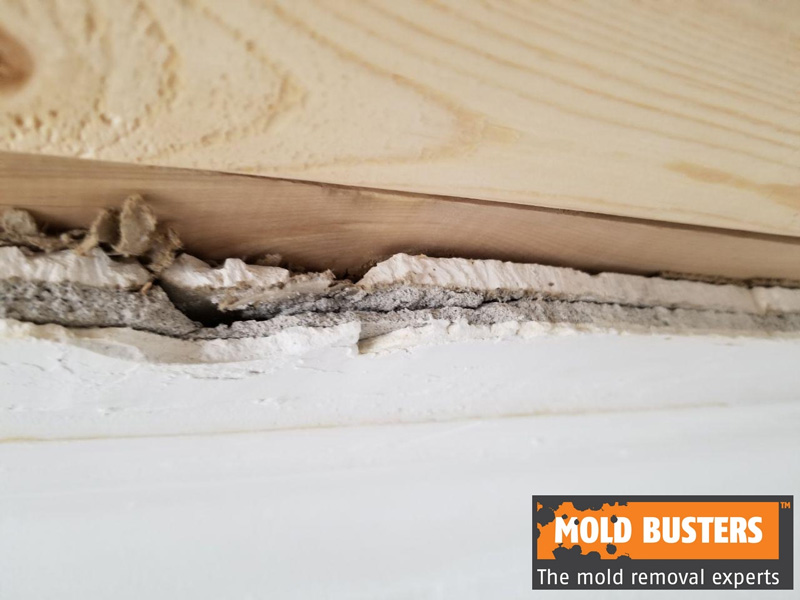
Examples of the six known types of asbestos can be seen and described in the images and captions below:
1. The most common type of asbestos—chrysotile (or “white asbestos”) — can sometimes be found in the roofs, ceilings, walls, and floors of various buildings and structures, including commercial and residential properties. It has also been used as insulation for pipes and ducts.
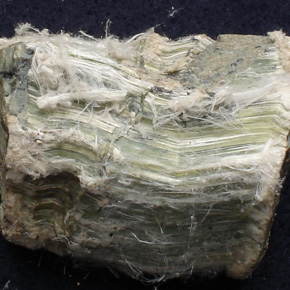
2. Crocidolite (or “blue asbestos”) was once used to insulate steam engines.
It can also be found in spray-on coatings, pipe insulation, and cement products.
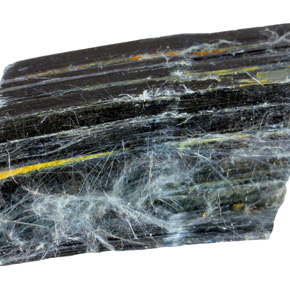
3. Amosite (or “brown asbestos”) was often used in cement sheets and pipe insulation, though it was also used in ceiling tiles, insulating boards, and other thermal products.
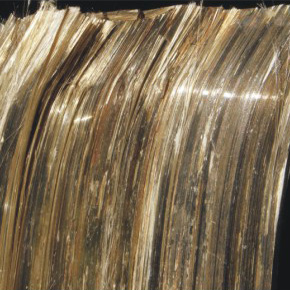
4. Anthophyllite asbestos was typically used in limited quantities for insulation products. It can act as a contaminant of chrysotile asbestos and talc. In colour, anthophyllite asbestos can appear as dull green, white, or grey.
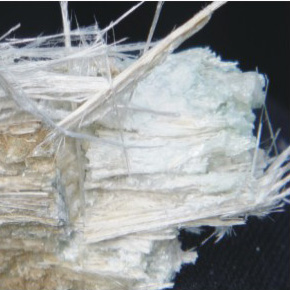
5. Tremolite and actinolite asbestos are not used commercially, but like anthophyllite, they can also act as a contaminant of chrysotile asbestos products. In colour, tremolite and actinolite fibres can be transparent, white, brown, green, or grey.
How dangerous is asbestos in drywall?
If left sealed and undisturbed, asbestos in drywall is usually safe. However, if exposed, asbestos in drywall can pose a number of severe health risks to you and your loved ones including:
- asbestosis (scarring of the lungs which causes difficulty breathing)
- lung cancer, and
- mesothelioma (a rare form of cancer that attacks the chest lining and abdominal cavity)
Since asbestos exposure does not cause any immediate or noticeable symptoms, the fibres can stay in your body for years before any asbestos-related illnesses become apparent.
Asbestos in drywall mud safety recommendations
As a homeowner, you are most at risk of asbestos exposure during renovations. Small asbestos fibres can be disturbed and released unnoticed into the air when sanding, scraping, or demolishing older surface treatments that contain asbestos such as drywall, spackling, caulking, putty, sealants, or paint.
Precautions should also be taken when: removing insulation (including the insulation around hot water pipes and tanks), breaking soundproof ceiling tiles, removing roofing shingles, and sawing, drilling, or smoothing out the surfaces of rougher materials in the home.
Asbestos fibres can be easily inhaled during the most basic of renovations, so these measures should be taken in order to ensure the safety of yourself and others while working on your home.
How do you identify asbestos in drywall?
The first step to identifying asbestos in drywall is determining what year your home was built. Again, if it was constructed anytime between 1950 and 1990 (and hasn’t undergone any recent renovations or construction), it is safe to assume that there are high levels of asbestos either in the drywall, tiles, piping, or elsewhere.
While it is difficult to identify asbestos by sight alone, you can look for other warning signs such as older, unlabelled construction materials that are showing signs of degradation and wear. Modern products that contain low or acceptable levels of asbestos are fortunately labelled as such.
How do you test for asbestos in drywall?
In order to effectively prepare your home for asbestos testing, it is recommended that you do the following:
- Turn off any fans or vents that could cause potential asbestos fibres to become airborne.
- Close off the affected area in order to prevent cross-contamination.
- If possible, make plans to leave the home during the asbestos test(to minimize your risk of asbestos exposure).
While there are some DIY kits available for testing asbestos in drywall, we encourage you to seek the expertise of a professional trained in safe and accurate asbestos testing and removal.
Asbestos in drywall sampling – Professional procedure
Step 1 – Map out your cut guide
Step 2 – Measure your area. Drywall joints found roughly at 4FT mark. Stay clear from electrical sockets or fixtures.
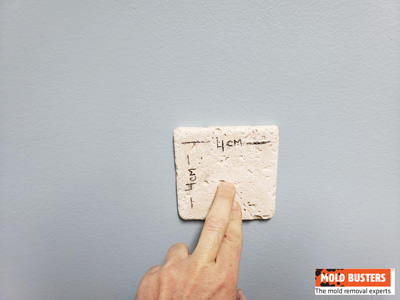
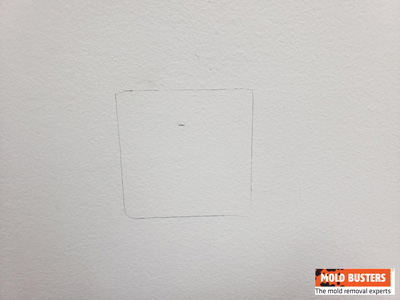
Step 3 – Protect area beneath sampling zone
Step 4 – Spray/Dampen area and make triangular incisions to cut. Use knife, blade, or chisel.
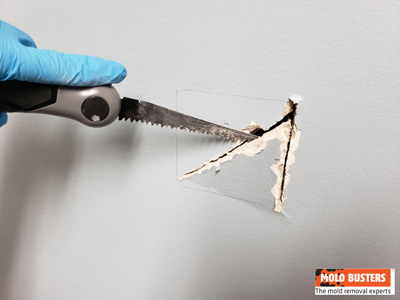
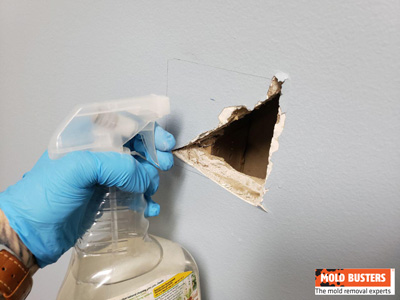
Step 5 – Place sample directly into ziploc bag
Step 6 – Dampen/Spray area and make next incisions
Step 7 – Clean all surface areas
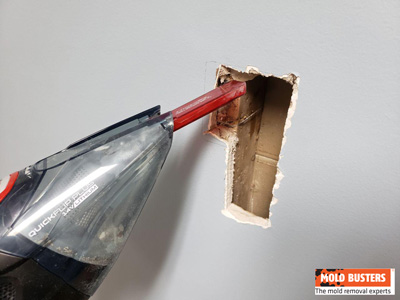
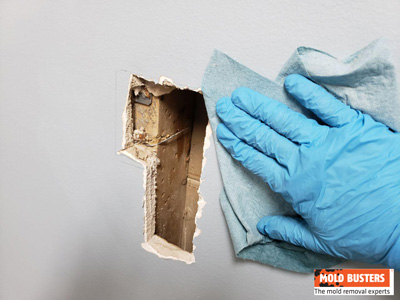
Step 8 – Patch up incision zone with polyethylene (6ml) and strong tape
Step 9 – Ensure warning sticker is affixed
Step 10 – Leave the area cleaner than you found it
But, sometimes, you also get a surprise…
Hidden pipe with a potential asbestos insulation wrap, which also should be tested.
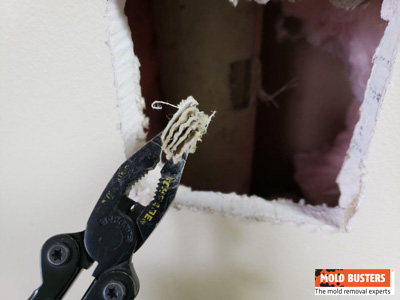
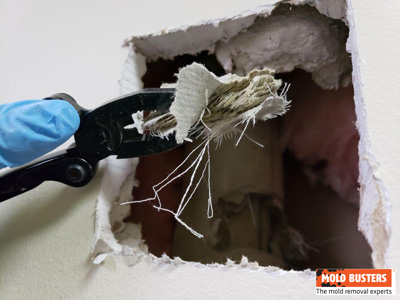
How to remove asbestos in drywall — are there any DIY solutions?
Again, though it might be tempting to look into DIY solutions for removal of asbestos in drywall, we urge you to contact a qualified contractor who is skilled in asbestos removal. There are qualified asbestos abatement experts in your area that would be happy to assist you in this process.
Where to dispose of asbestos in drywall?
Competent contractors will usually handle the disposal of asbestos contaminated materials either as part of their initial contract or for a set fee.
What are the costs of removing asbestos in drywall?
Depending on the size of your home, where you live, and the severity of the contamination, the cost of asbestos removal in drywall and other materials can fluctuate.
This is why most asbestos abatement companies insist on conducting a scope-of-work inspection before providing a quote for remediation.
Why should you hire a professional to test for asbestos in drywall?
At Mold Busters, we come to you and remove a sample of the suspicious material, which we then send off to a third-party accredited laboratory for complete testing and analysis.
There, the drywall sample is analyzed using polarized light microscopy (PLM) for traces of asbestos. Once the results are in, we send you a complete report along with recommendations for removal.
Hiring a professional to test for asbestos in drywall is easy, efficient, and gives you peace of mind knowing that you are living in a comfortable and safe environment.
Asbestos in drywall is a threat still faced by many homeowners today. At Mold Busters, we hope to help eliminate that threat by sending in our contractors to ensure that your home is the very best that it can be.
Together, we can strive towards a domestic environment free of worry and illness.
Call us today to talk to one of our representatives about testing for asbestos or any of our other indoor air quality services.

Get Special Gift: Industry-Standard Mold Removal Guidelines
Download the industry-standard guidelines that Mold Busters use in their own mold removal services, including news, tips and special offers:
Published: May 1, 2023 Updated: August 18, 2023

Written by:
John Ward
Account Executive
Mold Busters
Fact checked by:
Michael Golubev
CEO
Mold Busters


